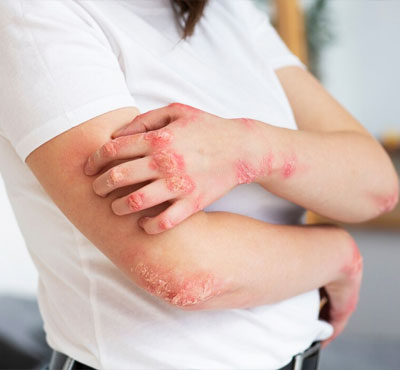What Is Eczema (Atopic Dermatitis)?
Eczema is a chronic inflammatory cutaneous disease that produces dried, itchy and irritated skin. It tends to begin in childhood but is also possible in adult life. Even though there is currently no cure for eczema, optimal management can effectively reduce the symptoms and flare events.
Symptoms of Eczema
Eczema symptoms can vary from patient to patient and commonly fluctuate between periods of remission and flares. Common symptoms include:-
- Intense Itching - Itching is a hallmark of eczema and may be severe enough to disrupt sleep or daily activities.
- Red or Brown Patches - They can also occur in the face, neck, hands, feet and the inner aspect of elbows and knees.
- Dry, Cracked Skin - The dried and exfoliated areas can peel or crack.
- Weeping or Crusting - At the severe stage skin may exudate or dry out as crust.
- Thickened Skin - Compulsive scratching has been described to lead to lichenification, i.e., thickened, leathery skin.
Causes of Eczema
The exact pathogenesis of eczema is still unknown, but it is assumed to be caused by a genetic predisposing factor, environmental trigger and immune response.
- Genetic Predisposition - Patients with a familial history of eczema, asthma and allergic rhinitis are at risk of the disease.
- Skin Barrier Dysfunction - Skin barrier dysfunction with the ability to easily gain access to irritants, allergens and microbes exists in eczema patients.
- Immune System Overreaction - Excessive immune response causes inflammation and it, in turn, exacerbates the symptoms.
- Environmental Triggers - Common etiological factors are allergens (dust mites, pollen), irritants (soaps, detergent), meteorological alteration, and stress.
Types of Eczema
- Atopic Dermatitis - The most common form, atopic dermatitis, often occurs alongside other allergic conditions like asthma or hay fever.
- Contact Dermatitis - This occurs when the skin is sensitized to either an irritant or allergen that is due to the topical application of it.
- Dyshidrotic Eczema - Dyshidrotic eczema is a form of erythematous papular lumpy or smooth blisters over the hands and feet, and its manifestations are stress or moisture-induced.
- Nummular Eczema - This form is characterized by round coin-shaped patches of inflamed skin.
- Seborrheic Dermatitis – Penetrates scalp, face and chest as oil is well perfused and is associated with dandruff.
- Stasis Dermatitis - Develops in the leg, as a complication of occlusive and congestive disorders of the leg.
Diagnosis at Dermavision - The Skin Clinic
Proper diagnosis is crucial for effective treatment. At Dermavision - The Skin Clinic, our dermatologists perform:-
- Physical Examination - Identifying symptoms like redness, swelling, and dryness.
- Patient History - Understanding family history, triggers, and symptom patterns.
- Allergy Testing - Allergens can be screened using patch or skin tests.
- Skin Biopsy - On very rare occasions a biopsy is done to exclude other diseases.


